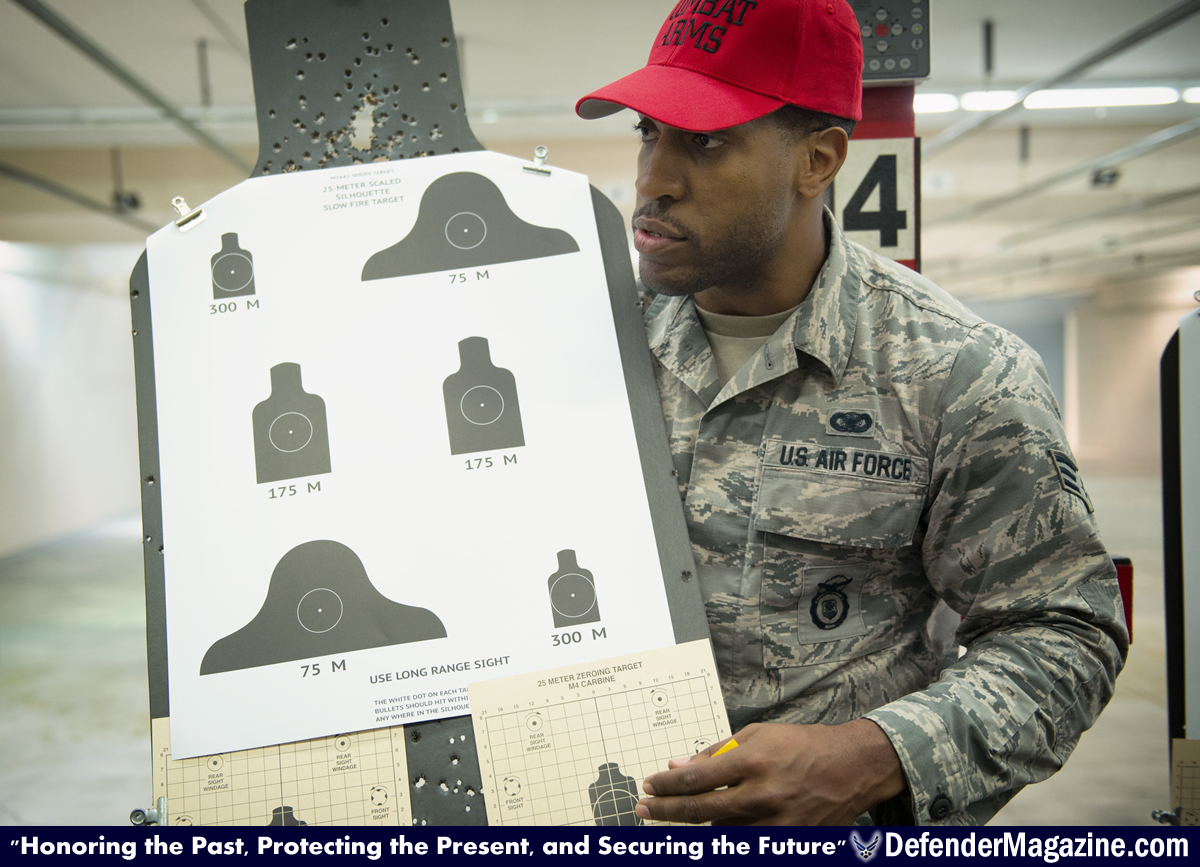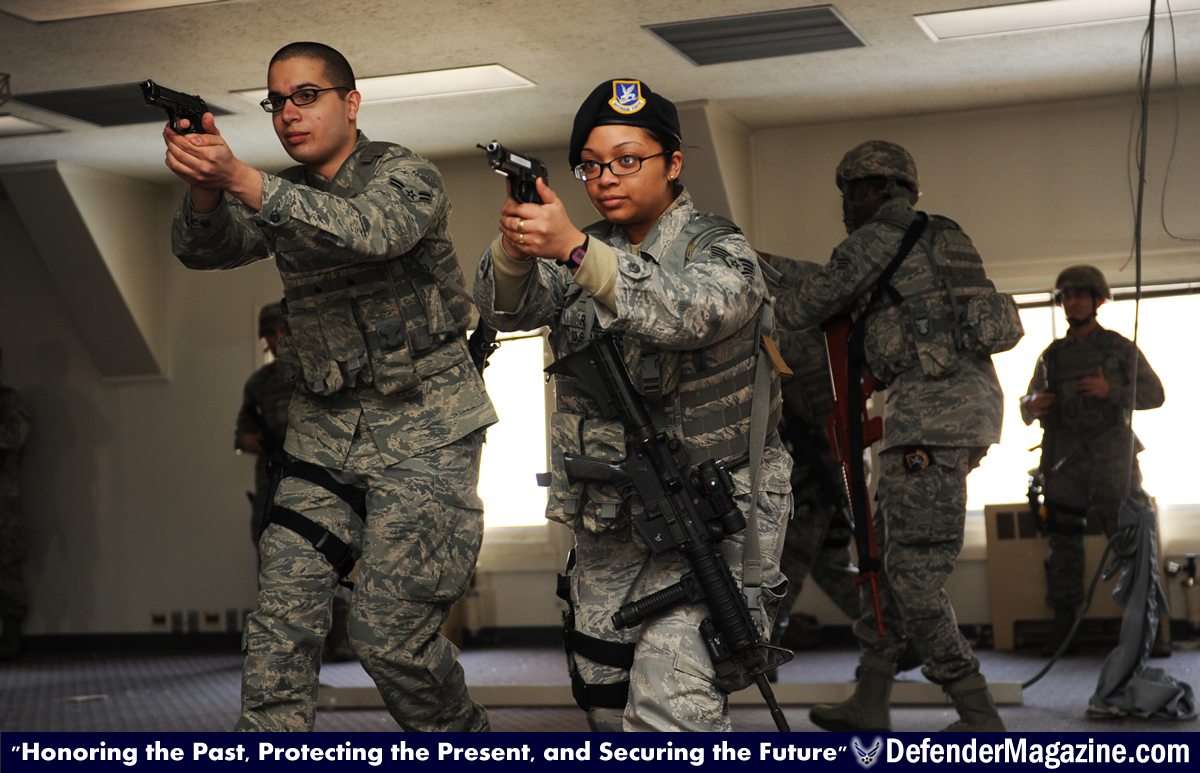
02/26/16 – There is some debate on whether or not Air Force Security Forces members should qualify for the Law Enforcement Officer Safety Act (LEOSA).
In recent years LEOSA was amended to include military law enforcement personnel, both military members and civilian police officers working for the military. The caveat that differentiates military law enforcement from civilian law enforcement professionals is that DoD (each branch) had to create a policy to cover their respective branch and the Air Force spearheaded this endeavor.
The Army is in the process of drafting their standards and the Navy seems to still be scratching their heads. I’m guessing the Marine Corps will fall under the Navy’s program when and if it comes to fruition.
The topic of conceal carry for military members has come up since the shooting at a military recruiting station and reserve center a few months ago and the common argument, or complaint, seems to be “this is BS, I can carry a gun in combat, but not in America!” Fun fact – roughly only 10% of military members are in combat arms type career fields (infantry, artillery, TACP, fighter pilot, etc.), and yes, every Marine is a rifleman and every Soldier is a grunt, but not a whole lot of these riflemen and grunts qualify on handguns, nor do they carry them on any regular basis. In my 10 years as an infantryman, I shot the M-9 pistol only once, as a machine gunner, where the M-9 is your secondary weapon.
A lot of airmen have little confidence in Security Forces and often complain about the career field as being the place where everyone goes who fails out of other careers. As the largest enlisted career field in the Air Force, it’s easy to point fingers when there’s almost always a defender within sight. That aside, Security Forces do in fact get a lot of firearms training to include the M-9 pistol. So if any one career field, in mass, should be issued a credential that merely allows them to carry a personally owned concealed handgun legally, and in lieu of state issued Conceal Carry Weapons permits, it only makes sense for that career field to be Security Forces.
What is the difference between a Conceal Carry Weapon (CCW) permit and the Air Force Security Forces LEOSA credential? The only difference as far as carrying a weapon is that the LEOSA credential is recognized nationwide and allows the bearer to carry in a few more places than state issued CCW permits. That is it!
When it comes to CCWs, the rules vary greatly from state to state, and in many states it is still difficult to obtain a permit. It’s easy in South Dakota, where the fee to obtain the four-year permit is only $10 and there is no training requirement. By contrast, Illinois charges a $150 fee and requires 16 hours of training; but the training and range time in Illinois can cost between $450 and $500, putting the total dollar costs of getting a permit over $600. Not surprisingly, concealed carry is much more popular in states where permits are relatively inexpensive and easier to obtain.
Senior Airman Dominique Adams, 374th Security Forces Squadron combat arms instructor, briefs students on proper weapon aiming and positioning techniques at Yokota Air Base, Japan, Oct. 8, 2015. The combat arms maintenance and training trains between 2,500 – 3,000 students each year. (U.S. Air Force photo by Airman 1st Class Delano Scott/Released)
Florida, where permits have reached over one million, only requires “any type of firearms training”. The list of acceptable training is vague and includes, as an alternative, proof of “military service”, not firearms training in the military. As an example, my wife, an Air Force public health specialist, has been in the Air National Guard for 12 years and has shot the M-16 rifle once in basic training, and once at her unit back in 2007. Her training and experience still meets the requirements to be issued a CCW. My wife later took a CCW course in Florida that met the training requirements to be issued a permit. There, they talked about conceal carry laws and then she had to prove competency with a pistol by hitting a target six times. Permits are not required to carry a concealed handgun in six states, so in those six states, there are zero training requirements.
When it comes to training requirements for the LEOSA credential, it is not a handout after graduating the Security Forces Apprentice Course. There is a long list of requirements that include obtaining the 5 skill level, completing one year probationary period after completing all Peace Officer Standards and Training (POST) requirements noted in DoDI 5525.15 Attachment 4, and qualifying annually with a handgun either by the Air Force (AF522) or state certified firearms instructors.
Again, the LEOSA credential is virtually the same as a state issued CCW permit, but recognized nationally. Where some states have little to no training requirements, all Security Forces members have more than 500 hundred hours of law enforcement, combat, and firearms training (see below), plus are required to qualify annually.
Finally, two common myths about the LEOSA credential:
- Carrying a LEOSA credential does not give the bearer any law enforcement powers or privileges outside of carrying a concealed handgun. It does not give the individual the power of arrest or any ability to act on behalf of the Air Force or any law enforcement agency.
- The LEOSA credential does not allow the bearer to bring or carry firearms on military installations outside of the Air Force (ref: AFI 31-101 IC3, 3 DEC 2015).
Now, about that training our Security Forces members receive during the 13 week apprentice course, as well as follow-on and annual training at their respective units and compare that to what is required to obtain a state’s conceal carry permit:
Initial Security Forces Training – Security Forces Apprentice Course
Block I – Introduction to Security Forces = 24 Hours
Block II – Security Forces Weapons/Weapons Safety = 50.5 Hours
Block III – Heavy Weapons = 37.5 Hours
Block IV – Ground Combat Skills = 184 Hours
Block V – Police Services and Security Forces Fundamentals = 224 Hours
Total training hours (excluding processing and testing) = 509 Hours
Annual and Recurring Security Forces Training
In addition to annual Air Force wide ancillary training such as self-aid buddy care, information protection, CBRNE, etc., all Security Forces members must complete 41.5 hours of weapons qualifications, non-lethal weapons qualification, and Arming & Use of Force training annually.
U.S. Air Force Airman 1st Class Nicholas Davis, left, and Staff Sgt. April Riddle, 35th Security Forces Squadron defenders, practice proper transition drills during High Risk Response Training at Misawa Air Base, Japan, March 30, 2012. In combat, if a primary weapon fails, the ability to quickly transition to a sidearm could mean the difference between life and death. Regular training exercises like this, gave 35 SFS Airmen the ability to develop the skills and knowledge that resulted in the squadron earning the Air Force Outstanding Security Forces Medium Unit 2011. (U.S. Air Force photo/Airman 1st Class Kia Atkins/Released)
Training requirements only differ between active and traditional guard defenders when it comes to Security Forces Foundational Skills Training requirements.
Active duty defenders are required to complete 208 hours annually of home station training that includes both Security Forces and generalized training to be completed by all defenders, plus a variety of training that are specific to a unit’s particular mission sets.
Traditional Air National Guard defenders will complete 151 hours of Foundational Skills, Combat Readiness Skills, and AEF Tier 2B on a 39 month bases, and in-line with the unit’s scheduled AEF rotation.
If you ask me, that is a lot of training for individual who may lawfully carry a concealed handgun as an off duty defender in the United States; contrast this to a citizen who can lawfully carry a handgun who has zero training. I think the Air Force has got this one right.
By MSgt Peter K. Bowden
Air National Guard Security Forces


